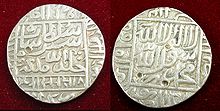Sher Shah Suri- the ruler who introduced 'Rupee'
Introduction
When we talk of transport and management of infrastructure, British Era comes to mind. British get credit for all innovations and modernization. On the other hand, there are many who go to very remote past of Ramayana and Mahabharata and claim that whatever we see today- from pin to spacecraft- existed in ancient India. For them, whatever has been or will be invented, existed during Ramayana and Mahabharata period.
However, Sher Shah Suri is the unique emperor in medieval history. He introduced the 'Rupaya' or 'Rupee' which is the offcial currency in India, Pakistan and some other states. He is also credited with organizing postal system and building Grand Trunk Road- from Chittagong (Presently in west Bengal) to Kabul (Afghanistan).
Life History

Sher Shah was born in Mahendragarh of Present Haryana. But some believe that he was born in Sasaram (Rohtas District Bihar). His grand father Ibraham Khan Sur was a Zagirdar (Landlord) in Narnaul area). His father, Mian Hassan Khan sur was prominent figure in administration of Bahlul Khan Lodi. Sher Shah belonged to Pashtun Sur tribe.
The original name of Sher Shah was Farid. During childhood, he did not get along with his father who had several wives. He ran away and got service under Governor of Jaunpur (Uttar Pradesh). His father came to know this and he wrote a letter to Jamal Khan, the Governor of Jaunpur. He requested that if his son Farid (Sher Shah) did not return to him, he may be kept at Jaunpur and given religious training.
Later, Farid Khan joined service under Bahar Khan Lohani, Mughal Governor of Bihar. The title of 'Sher Khan' was given by the Mughal governor to Farid Khan in view of his feat of killing tiger single handed. After death of Bahar Khan, Farid Khan became the regent ruler of the minor Sultan, Jalal Khan. Sher Shah defeated the independent sultan of Bengal in 1534 and got complete control of Bihar. In 1538, Sherkhan attacked Bengal and defeated the Sultan, Ghiyashuddin but could not capture the kingdom. In 1539, he faced emperor Humayun and forced him out of India. At this stage, Sher Khan assumed the title of 'Sher Shah' and occupied the throne of Delhi.
Sher Shah fought against Rajputana force under Maldeo Rathore in 1543. He had superior force but his position was critical because of difficulties in food supply. He forged some letters and got these leaked. Thus he got Maldeo Rathor suspicious of some of his generals. Then Maldeo left for Jodhpur abandoning the commanders. As a result, Sher Shah was victorious but many of generals lost their lives and his army suffered considerable losses. Consequently, Sher Shah was saddened. Moreover the victory proved short lived as after some time Maldeo reoccupied the territories he had lost earlier to Sher Shah.
Sher Shah died in an accident from an explosion during the siege of Kalinjar fort in May 1945. But many claim that his death was caused by fire in his store room. His son Jalal Khan succeeded him taking the title of Islam Shah Suri. However, soon Mughals took over the reigns.
We are less aware of Suri dynasty owing to its short duration. Mughal dynasty is best known because of longer duration. However, Sher Shah Suri laid foundation of good administration. This was of great help to Mughal and later even British. However apart from Grand Trunk Road, there are some monuments that still remind us of Sher Shah Suri. Rohtas Fort, a world Hertage site (Pakistan), Rohtas Fort in Bihar, Sher Shah Masjid in Patna, Quila Kuhna mosque at Purana Qila Delhi are such monuments.
Shersabadia community
The shersabadia community owes its allegiance to Sher Shah Suri. As long as this community lives, Sher Shah suri lives. When sher shah suri escaped from invasion from Bengal, some soldiers were left behind. Those soldiers made a colony called shershahabad. As course of Ganges changed, this colony ceased to exist. The residents known as shersabadia dispersed and are seen in Malda, Mushidabad, Chapai Nawabganj and some other places that are no more in India.
An innovative administrator
Sher Shah Suri was rare monarch in Pre British history, who worked for improving administrative system as against others who simply cared to expand territory or build luxurious buildings. The Mughal tri- metalism coinage system was introduced by Sher Shah Suri. The term 'rupaya' was used previously for any silver coin. During reign of Sher Shah Suri, there was standardization of 'rupaya'. The coin was to be of standard weight of 178 grams. Modern rupee is an improvement on the system introduced by Sher Shah Suri. Gold coins were known as 'Mohar', consisting of 169 grains. Copper coins were known as Dam.

Presently, Rupee (English name for 'rupaya') is national currency of India. Many other countries viz. Nepal, Indonesia, Nepal, Pakistan and some others also have Rupee as their currency.
Sher Shah's administration has been well described by Abbas Khan Sarwani in his book Tarikh-sher Shahi. Grand Trunk Road is a living example of administrative skill of Sher Shah Suri. The road was improved by Mughal and later by British. The road has served commerce and communication for centuries. The sarais (inns) were constructed and shady trees planted for facility of travelers using the Grand Trunk Road.

conclusion
Sher Shah Suri undoubtedly is a guide to better administration. when we see Rupee, we are reminded of him. To commemorate his memory, we should have image of Sher Shah Suri on Indian currency notes and coins. His reign should be given a place of importance in modern administration studies and services like Indian Administration Service.
The images are from wikipedia.
Like it on Facebook, Tweet it or share this article on other bookmarking websites.

